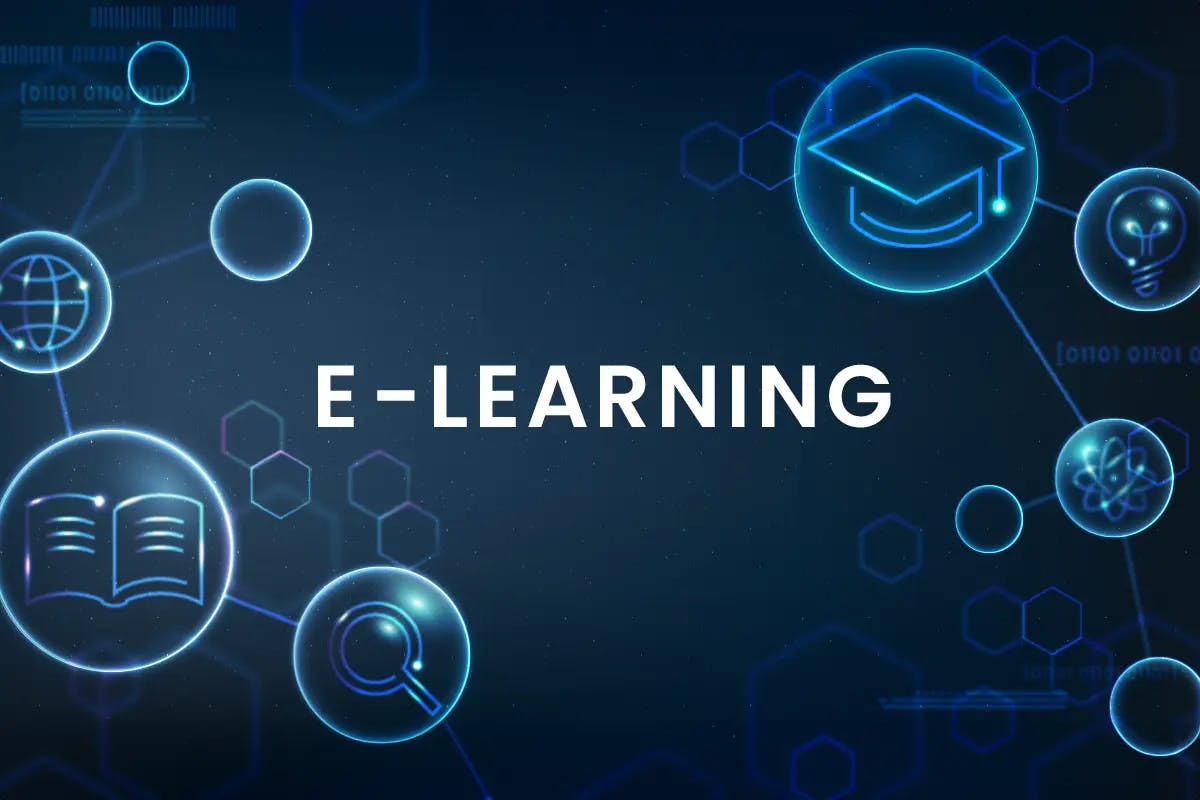
,
Digital education is a growing field that is using modern-day business environments where there is a rising demand for essential skills learning. Given the fast-changing nature of today’s digital environment, custom-made AI-based eLearning systems are indispensable for companies and individuals for the upskilling and training of their employees. Factors such as the explosion of technology like AI in education and the various needs for individualized or unlimited training programs have facilitated the rapid growth of eLearning.
According to a recent report published by Forbes, they predicted that the global eLearning market will grow by 20.5% from 2022 to 2030. The demand for it is mainly the use of mobile phones and the application of AI-driven (Artificial Intelligence) learning systems. The growth of custom eLearning is led by the demand for learning platforms that are affordable and scalable. In the article, we will explore important aspects of custom eLearning development and the various advantages associated with it.
What is Custom eLearning?
Custom AI-based eLearning is an approach where digital learning products are custom-made to meet the requirements and objectives of a person or company. In comparison with the standard eLearning items, which tend to follow a uniform approach, custom AI-based eLearning is personalized to reflect the particular learning goals of an individual or a company. This adaptation is what makes businesses capable of developing training that is well-suited to the learner and can still be attention-grabbing, and appealing. This will ultimately lead to an efficient learning process.
Custom AI-based eLearning modules can be in various forms like interactive modules, video-based modules, simulations, and/or gamification. These formats help to keep the interest and attention of the learners throughout the learning process.
Benefits of AI in custom eLearning solutions
As per recent findings by research.com, 77% of the eLearning industry consists. of self-paced learning models. This huge percentage shows the increasing popularity of custom eLearning platforms. Let us find out the various benefits associated with it:

- Personalized Learning
Custom AI eLearning is a means to come up with the content that is the most suitable for their particular audience or user rather than a one-size-fits-all approach. This customization adds a touch of personalization to the learning process that matches up with the unique requirements of the learner. Personalized learning with AI tracks enable learners to advance at their own speed paying specific attention to those areas where they are still having the most difficulties. - Better Engagement
Interactive components such as quizzes, simulations, and gamification can be added to AI-driven course recommendations to attract learners. These types of components help to increase the learner's engagement. - Scalability
Custom AI eLearning solutions can be modified to keep up with the latest industry trends, and technological advances. The updates that are made possible by this easy adaptation, therefore, ensure the learning materials are still relevant and updated. The other advantage of custom eLearning is the possibility of scalability for a growing workforce or for new learning objectives. - Enhanced ROI
Custom AI eLearning solutions provide a higher return on investment compared to generic training programs. These kinds of programs also help businesses look at how to evaluate and track their employee's progress and performances.
The Custom AI eLearning Development Process
Creating a custom AI-driven eLearning solution involves many important steps, each of which is essential to the success of the finished product. Here is a brief explanation of the usual AI based custom AI eLearning development process:

Analysis Phase
The phase is basically the primary activity in AI-based eLearning development when it comes to custom development. This is a time when businesses perform rigorous needs assessments to recognize the learning goals and objectives. It consists of a study about the target audience, their preferences, and their current skill level. The primary steps in the analysis phase include:
- Needs Assessment
To begin with, the learning objectives and outcomes of the educational program should be identified correctly. This process comprises the application of relevant skills and knowledge that are necessary to present the required content. - Audience Analysis
Knowing the demographics, learning preferences, and existing knowledge levels of the target audience is necessary for creating custom content. This type of custom objective assessment helps to produce content that learners will find interesting and the teachers will be able to help the students to address their needs. - Content Evaluation
It is important to evaluate the training materials you already have to recognize the content. It can be reused or changed for the new eLearning program as per the requirements. This will make the AI-based custom development process more swift and also ensure that the message is consistent. - Technology Assessment
The organization’s technology capabilities and infrastructure will be assessed to find out which eLearning platforms and tools would be the most suitable ones. In the tech assessment stage, a compatibility check of the existing systems to the new eLearning solutions is also being conducted.
Design Phase
The design phase includes the conversion of the analysis results into a detailed plan for the eLearning project. The main components in design phase defines below:
- Storyboard Creation
It starts with the preparation of a storyline that plans out the course structure, content ordering, and elements, i.e.images and interactivity. This is a preparatory document for the entire course providing a detailed layout and sequence of activities, and AI-powered assessments. - Prototype Development
The course's design is experimented with the development of a test version. This is employed to get feedback from stakeholders. The prototype is a way of showcasing the course and editing the design before the course is fully developed. - Visual Design
Create the visual features of the course by using graphics, animations, and user interface components. Visual design will help to align your organization's brand with target customers and establish an interesting and simple learning experience. - Instructional Design
Implement instructional strategies that relate to the delivery method and take care of the target group's requirements. This is the choice of the most suitable content formats, delivery methods, and assessment techniques.
Development Phase
The development phase comprises different eLearning content, focusing on the use of multimedia like video clips, animations, and graphics. The main activities in this phase are as follows:
- Content Creation
Course content should be in line with the storyboard and instructional design plan. The process includes writing scripts, creating multimedia assets, and programming interactive elements. - Interactivity Integration
Integrate interactive content like quizzes, simulations, and scenarios that will help to capture interest as well as improve the student retention. These elements are a way for learners to practice what they have learned and then the system will give back their immediate feedback. - Technical Development
As a major part of the development of the course, the technical aspects need to be specified. For example the design of a user interface, integrating multimedia elements, and configuring navigation and interactions. - Quality Assurance
Conduct thorough testing required to make sure the course works as expected and is of the highest quality. This means checking for issues like technical problems, the truthfulness and relevance of the content, and last but not least - ease of use.
Implementation Phase
The implementation process starts by putting up the eLearning course on a Learning Management System (LMS) or other delivery methods. The main activities of this phase is:
- LMS Integration
To keep an eye on the student's progress you need to put the course on your LMS. LMS helps with a single platform to store, manage and avail the training courses. - Pilot Testing
Plan a trial run with a sample of individuals to find any areas for betterment or matters that need fixing. The pilot test results are used to make the important changes before the full-scale deployment. - User TrainingThe next step is to provide training and support for learners and educators to ensure a smooth transition to the new eLearning program. The first step of successful training and support is to offer guidelines on how to access and move through the course.
Evaluation Phase
The evaluation stage evaluates eLearning courses and ensures continuous improvements. The steps in this phase include:
- Feedback Collection
Seek responses from students and educators to gauge the course's impact and spots where you can make improvements. Evaluation might take the form of questionnaires, interviews, assessments, etc. of student academic performance. - Performance Analysis
Learner performance data analysis would be a best way to scale how effective the course is in improving performance and achieving the goals. This evaluation would help in outlining any trends and those areas that may need more support or intervention. - Continuous Improvement
Use the feedback and performance data for the required upgrades in the course content and delivery. This will help in making the training program more impactful over time.
Key Considerations in AI Based Custom eLearning Development
Let us now explore some key considered that need to be kept in mind while going with the AI based custom AI eLearning development:
Aligning with Goals
One of the most important elements in custom eLearning development is to make sure that the training program is in line with the broader goals. This alignment will help to make learning more effective for individuals as well as for businesses. Below are the steps associated with this process as follows:
- Identifying Objectives
To begin with, the objectives that the eLearning program is supposed to deliver are clearly outlined. Such objectives could be in multiple forms like increasing worker output, upgrading customer service, or promoting creativity. - Measuring Learning Objectives Based on Goals
The learning objectives should be in line with the actual goals. Being aligned with this goal will help to deliver the right content based on individual needs. - Engaging Stakeholders
Including the key stakeholders in the development process is necessary to make sure that the eLearning program satisfies their demands and preferences. This should have them working together with the heads of departments, subject matter experts, and HR teams.
Technology Used in Custom eLearning Development
- AI
Artificial Intelligence can create adaptable learning experiences where the content and tests are designed as per the requirements of the individual students. AI-driven analytics also helps to measure and assess the performance and behavior of the students in the class. - Augmented Reality (AR) and Virtual Reality (VR)
VR and AR have improved the field of eLearning in various ways. AR and VR help to simulate the actual environment. This helps the learners to feel the actual environment and learn the lessons more practically. This real-world simulation helps to improve engagement. - Mobile Learning
Using mobile learning, learners can access their training material on any mobile device. This accessibility improves flexibility and convenience. This process involves mobile-friendly design and responsive content development. - Cloud-Based Platforms
Cloud-based eLearning platforms are more accessible as they do not depend upon the physical presence of the servers. Cloud-based AI education platforms make the process more accessible as learners can now access educational content beyond any physical boundaries.
Measuring Success
The performance assessment of a customized eLearning program is the key to knowing the working capabilities of the platform. Performance should be assessed by defining some KPIs. Some of the important metrics are as follow:
- Learner Satisfaction
Measure learner satisfaction by conducting surveys and feedback forms. If the satisfaction level is high, it means that the trainers kept the course engaging and relevant. - Knowledge Retention Rates
Test the extent to which students remember what they learned through quizzes and tests. Good retention rates mean that students understand the training material properly. - Impact on Performance
Evaluate the impact of training on productivity and performance. This will become apparent through performance reviews, and other relevant indicators. - Return on Investment (ROI)
ROI for the eLearning program can well be tracked if the cost of development and implementation is compared to the benefits achieved. Besides the cost savings, all other benefits should be explored in this stage.
Trends in Custom eLearning Development for 2025
As we move forward into the year 2023, a few important patterns are changing the future trends in AI-based eLearning development. These trends typically indicate the changing needs of students and the growing integration of technology into the learning process.

Microlearning
Microlearning offers simple, small, and focused content that learners can go through while on the go. Such short-form and to-the-point content is very useful for fulfilling specific knowledge gaps. Microlearning helps to deliver targeted content that can be applied by the learners based on their needs. This provides learners with targeted information that can be applied immediately.
Gamification
Gamification is the process of using various gaming elements to bring excitement to the field of learning. Gaming elements like points, badges, and leaderboards help to improve the motivation of users driven by better engagement. A gamified experience takes advantage of human trends of competition and achievement. This brings on a more joyful and satisfactory learning process.
Personalized Learning Paths
The popularity of personalized learning experiences has certainly provided momentum for using adaptive learning technologies. The personal learning paths enable the learners to complete the courses at their own speed and according to their skill levels. The learners are provided the learning content according to their demands which leads to a more effective and less time-consuming learning process. Students can modify their learning process and adapt their learning sessions based on their individual needs.
Social Learning
One of the main aspects of social learning is the inclusion of collaboration and knowledge sharing into the eLearning process. This in turn creates a feeling of community among learners. With various forms of social learning like common forums, peer reviews, and group projects, students get to not only communicate with their peers but also get to know each other's experiences.
Conclusion
Custom eLearning development provides businesses with a critical tool to improve their learning programs. The use of advanced technologies, and the alignment with the ultimate goal, help institutions and businesses a new form of eLearning that is custom-made and more adaptive. The future of eLearning looks bright with the emergence of multiple tools and technologies. Those institutes and companies wisely joining these trends are more likely to produce quality eLearning solutions.
If you are thinking of creating a customized eLearning solution, then get in touch with the best Custom software development company. They have an experienced team of developers who can deliver personalized eLearning programs that can meet specific business goals. Codiste is the Top Custom AI eLearning solution provider in the USA to be partnered for developing eLearning solutions with their skills and knowledge in the latest technology and dedication towards efficient delivery. Looking for a solution for all of your eLearning requirements? Let’s arrange a call with our expert.



The Ultimate Guide to Agentic AI and Agentic Software Development
Know more
What is Agentic AI? A Beginner's Guide to the Future of Software Development
Know more
AI in Customer Service: Trends & Predictions for 2025
Know more
